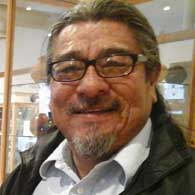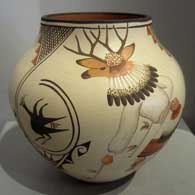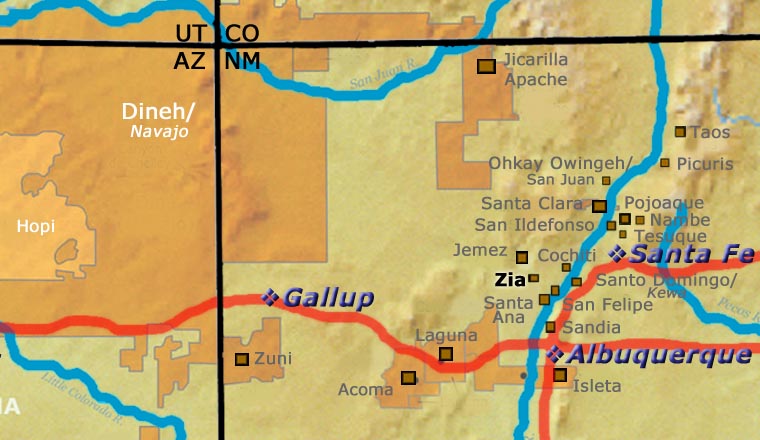
Marcellus Medina
Zia

Marcellus Medina was born to Rafael and Sofia Medina at Zia Pueblo in 1954. He began painting traditional and contemporary images with watercolor and acrylics at the age of 10. His family has a long tradition of producing pottery and paintings and Marcellus is devoted to the continuation of that.
His pieces have been featured in art shows at the Heard Museum Guild Indian Market in Phoenix, the SWAIA Santa Fe Indian Market, the New Mexico State Fair, the Mesa Verde Indian Art Show and the Indigenous Fine Art Market in Santa Fe. Some of his pieces are on display at the Cowboy Hall of Fame in Oklahoma, the Museum of Fine Art in Boston, at Albuquerque International Airport and in many private collections. While he has won many awards and recognitions for his accomplishments, he is most proud of his magnificent murals at the Poeh Cultural Center and Museum in Pojoaque, NM, the UNM Sandoval Regional Medical Center and the Mesa Verde National Park Visitor and Research Center. Marcellus has also had the honor of creating and producing the Gildan NM Bowl Football Championship Trophy Pottery for the University of New Mexico. He continues to add to his success by passing his knowledge and spiritual teachings on to others through the medium of his art.
Marcellus Medina's statement to us:
"The idea and concept of my work comes from my culture, religious belief and spirituality. These three elements are the central core of harmony - the balance of inner peace. Each of my pieces tells a positive story and depicts the reality of our being in this world. I express my feelings and visions through my art pieces which reflect the colors of the rainbow because, like the rainbow, my art changes its color prism randomly as with life and everything around it. The subject matter of human anatomy is complex and I enjoy the challenge of trying to capture the strength, costume, facial expression and beauty of the human form. The landscapes and horizons depicted are from the many places within New Mexico, the Land of Enchantment, that I have visited in my lifetime. I have embraced all the beautiful scenery of New Mexico and my artwork shows the style and grace that transpires from the feelings and visual effects that have a breathtaking blessing from the sky, land and oceans. My inspirations come from real life images, stories and imagination. As a Native American, my participation and sacrifice have heartened me to enjoy my experiences with my ceremonials, rituals, celebration of dance, and song and prayer."
Some Awards Won by Marcellus
- 2019 Santa Fe Indian Market: Pueblo Pottery Excellence Award shared with Elizabeth Medina. For creative excellence in the use of traditional materials and Native techniques and designs in Pueblo pottery
- 2019 Santa Fe Indian Market, Classification II - Pottery, Division B - Traditional Painted Pottery, Category 604 - Painted polychrome pottery in the style of Jemez, Zia, Santa Ana, Sandia, San Felipe, Isleta, any form: First Place shared with Elizabeth Medina
- 2017 Santa Fe Indian Market: Classification II - Pottery, Division B - Traditional, Category 604 - Painted polychrome pottery in the style of Jemez, Zia, Santa Ana, Sandia, San Felipe, Isleta, any form: First Place
- 2000 Santa Fe Indian Market, Classification III - Paintings, drawings & graphics, Division B - Paintings, realistic style (three dimensional), Category 1906 - Opaque water-based paint: Third Place
- 1999 Santa Fe Indian Market, Classification II - Pottery, Division E - Traditional pottery, jars with painted designs on matte or semi-matte surface: Best of Division with Elizabeth Medina
- 1999 Santa Fe Indian Market, Classification II - Pottery, Division E - Traditional pottery, jars with painted designs on matte or semi-matte surface, Category 1206 - Jars, Zia, Santa Ana, Santo Domingo or Cochiti: First Place with Elizabeth Medina
- 1998 Santa Fe Indian Market, Classification II - Pottery, Division E - Traditional pottery, jars, painted designs on matte or semi-matte surface, Category 1206 - Jars, Zia, Santa Ana, Santo Domingo or Cochiti: Honorable Mention with Elizabeth Medina
- 1993 Santa Fe Indian Market, Classification III - Paintings, drawings, and graphics, Division A - Paintings, traditional Native American style (2-dimensional), Category 1801 - All pueblos: Third Place
- 1992 Santa Fe Indian Market, Classification III - Paintings, drawings, and graphics, Division A - Paintings, traditional Native American style (2-dimensional), Category 1801 - All pueblos: Second Place
- 1983 Santa Fe Indian Market, Classification III - Painting and Prints, Division A - Painting: Third Place
100 West San Francisco Street, Santa Fe, New Mexico 87501
(505) 986-1234 - www.andreafisherpottery.com - All Rights Reserved

Zia Pueblo

A typical view on the Zia Reservation
Zia Pueblo is situated in the Jemez Mountains with Jemez Pueblo to the north and Santa Ana Pueblo to the south. Despite its picture postcard setting, Zia's history for the last four hundred years has been difficult.
Antonio de Espejo led a small troop of Spanish explorers up the Jemez River and discovered Zia Pueblo in 1583. Espejo estimated there were about 4,000 inhabitants in a city of house blocks up to three and four stories high with five major plazas and many smaller ones. "The people are clean. The women wear a blanket over their shoulders tied with a sash at their waist - their hair cut in front, and the rest plaited so that it forms two braids, and above a blanket of turkey feathers," is how Espejo's scribe recorded it.
Zia today is a water-poor community of about 800, most of whose residents work away from the pueblo.
The people of Zia participated in the Pueblo Revolt of 1680 and when Spanish troops returned in 1682 and 1687, the Zias were able to repulse them. When more Spanish troops returned in 1688 they were finally successful in conquering the Zias. The Spanish killed many people, burned the pueblo and took many slaves back to Mexico with them. When Don Diego de Vargas returned to northern Nuevo Mexico in 1692, the Zias sued for peace and accepted the rule of Spain almost immediately. However, the new Spanish government did little to protect the pueblos from the raids of nomadic Ute, Apache, Comanche and Navajo warriors. Zia fortunes slid in many ways and by the 1890's the tribe was down to just 98 members.
Today, the Pueblo of Zia numbers about 800 people, many of whom are active artists producing everything from pottery to jewelry to baskets to paintings, sculptures and wood carvings.
Pottery was a Zia mainstay for at least two hundred years. The balance of trade was food from Santa Ana, Jemez and San Felipe in return for pottery from Zia. Pottery still remains Zia's largest home-grown cash crop.
Zia pottery is Keresan and as such, shares design characteristics with other important Keresan pottery, especially Acoma and Laguna ware. They all have their favorite geometric patterns, stylized birds, rainbows and flowers, but each maintains its own individual images and colors.
Where Acoma and Laguna's bird is a parrot, Zia's is a roadrunner. Acoma's black and orange on stark white is contrasted by Zia's dark brown and brownish red on creamy white. Further, Acoma's hard, paper-thin, white clay ollas differ greatly from Zia's sturdy, slightly granular, basalt-tempered red clay jars. Because of their unique local clay and their traditional designs and shapes, Zia pottery is unique and easily distinguished from the pottery of other pueblos.
When New Mexico became a territory (and then a state), some of the symbols involved were sourced from Zia Pueblo. The roadrunner often pictured on Zia pottery became the official New Mexico state bird and the Zia sun symbol (a circle with four parallel lines in four groups pointing in the four directions) became a state symbol depicted in many places, including the state flag.
100 West San Francisco Street, Santa Fe, New Mexico 87501
(505) 986-1234 - www.andreafisherpottery.com - All Rights Reserved

Medina Family Tree
Disclaimer: This "family tree" is a best effort on our part to determine who the potters are in this family and arrange them in a generational order. The general information available is questionable so we have tried to show each of these diagrams to living members of each family to get their input and approval, too. This diagram is subject to change should we get better info.
-
Rosalea Medina Toribio (c.1858-1950) & Mariano Toribio (c. 1854-c.1918)
- Juanita Toribio Pino (1890-1987) & Andres Pino (1885-1947)
- Sofia Medina (1932-2010) & Raphael Medina (1929-1998)
- Marcellus Medina (1954-) & Elizabeth Medina (1956-)
- Kimberly Medina (1973-)
- Marcella Medina (1974-)
- Edna Medina Galiford (1957-)
- Lois Medina (1959-2002)
- Rachel Medina Raton (1961-)(married into Santa Ana)
- Student: Maxine Medina
- Marcellus Medina (1954-) & Elizabeth Medina (1956-)
- Sofia Medina (1932-2010) & Raphael Medina (1929-1998)
- Andrea Toribio Gachupin (1896-1956) & Jose Gachupin (ca. 1890-1953)
- Gloria Gachupin Chinana (1940-)
- Helen Gachupin (1931-1992)
- Maria Bridgett (c. 1890-)
- Candelaria Gachupin (1908-) & Antonio Gachupin
- Dora Tse-Pe & Johnnie Tse-Pe Gonzales (San Ildefonso)
- Candace Tse-Pe
- Gerri Tse-Pe
- Irene Tse-Pe
- Dora Tse-Pe & Johnnie Tse-Pe Gonzales (San Ildefonso)
- Candelaria Gachupin (1908-) & Antonio Gachupin
- Trinidad Medina (c. 1890s-1965)(Antonio Gachupin's sister, aunt of Dora Tse Pe, grandmother of Rafael Medina and teacher of Sofia Medina)
Some of the above info is drawn from Southern Pueblo Pottery, 2000 Artist Biographies, by Gregory Schaaf, © 2002, Center for Indigenous Arts & Studies
Other info is derived from personal contacts with family members and through interminable searches of the Internet and cross-examination of the data found.
(505) 986-1234 - www.andreafisherpottery.com - All Rights Reserved
